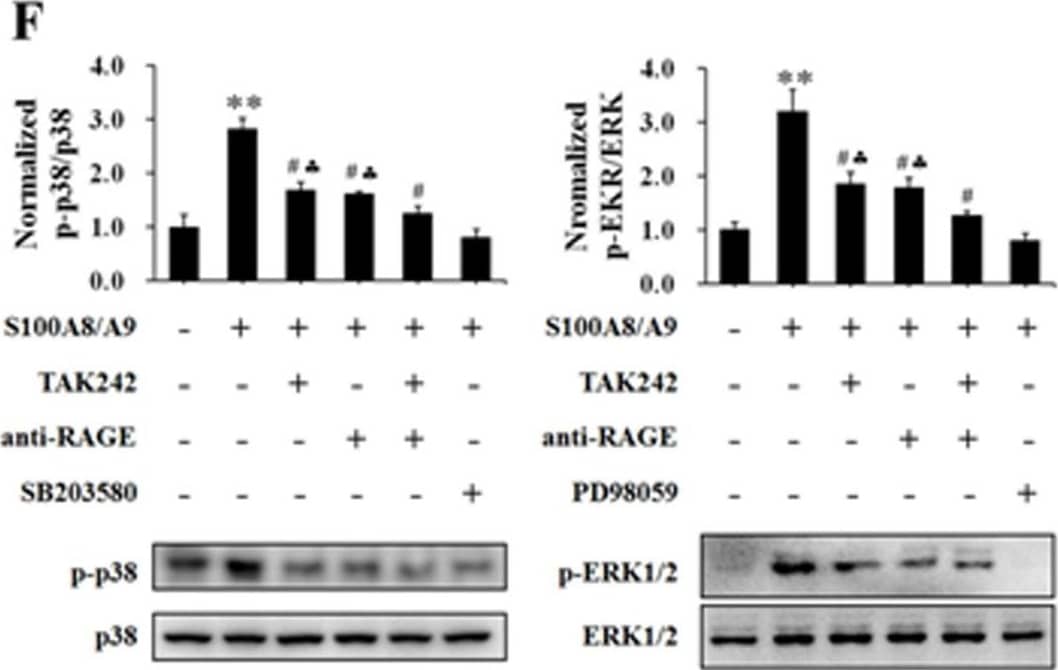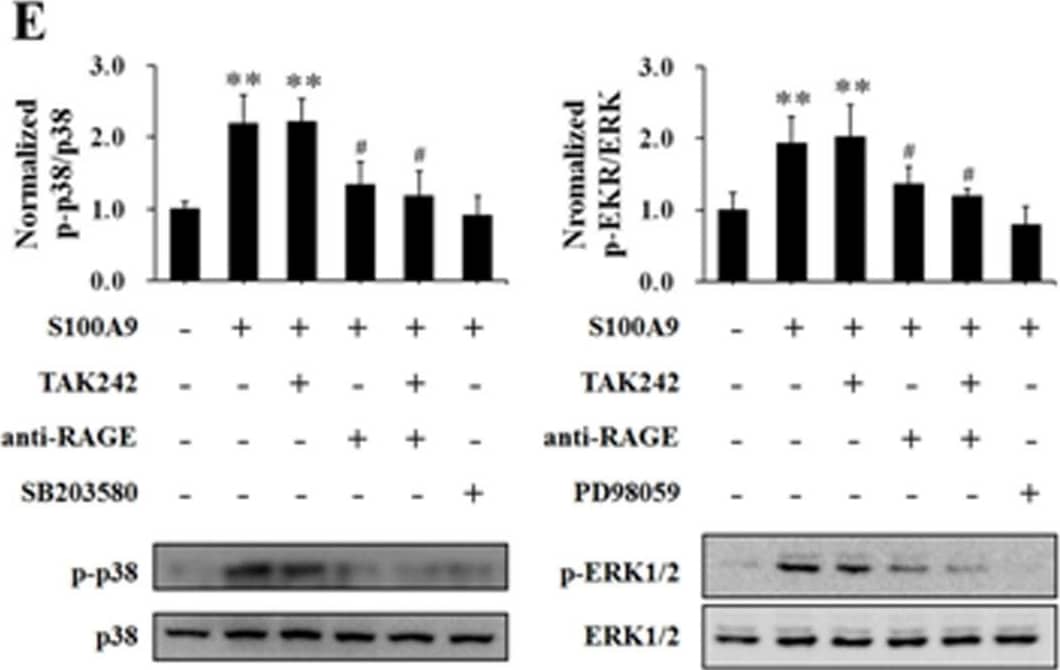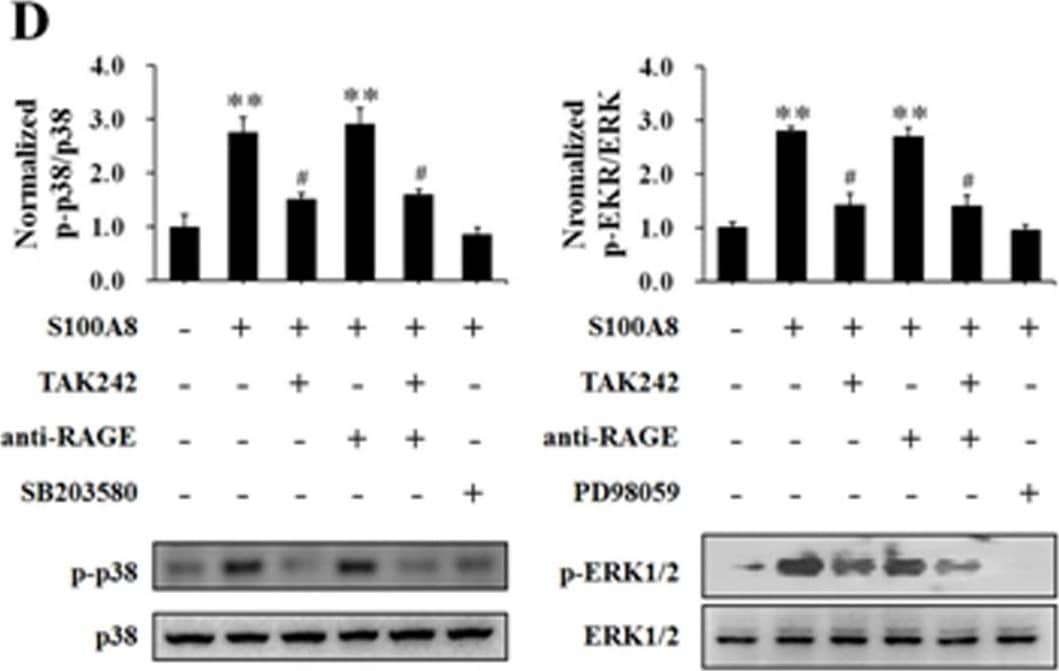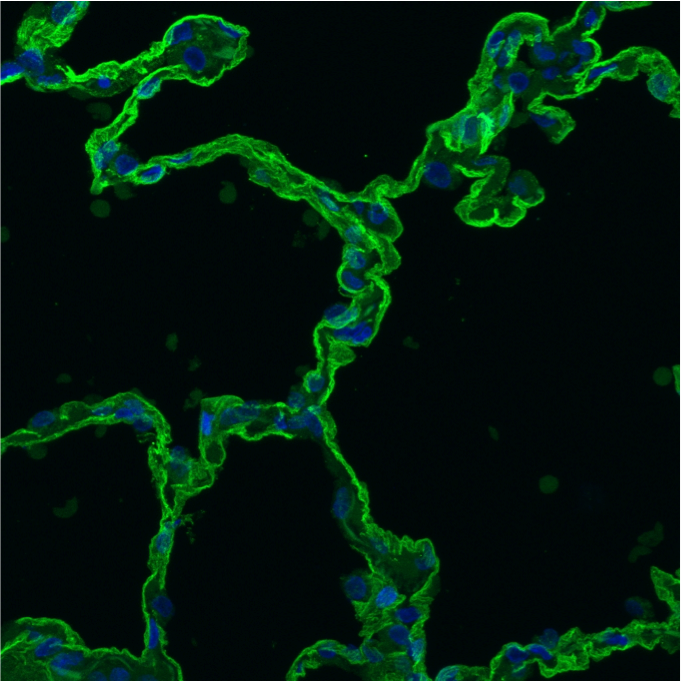Human RAGE/AGER Antibody Summary
Gln24-Ala344
Accession # Q15109
Applications
AGE-BSA to immobilized recombinant human RAGE/Fc Chimera coated at 5 μg/mL (100 µL/well). At 10 μg/mL, this antibody will block >90% of the binding.
Human RAGE Sandwich Immunoassay
Please Note: Optimal dilutions should be determined by each laboratory for each application. General Protocols are available in the Technical Information section on our website.
Scientific Data
 View Larger
View Larger
Detection of Human RAGE by Western Blot. Western blot shows lysates of human lung tissue. PVDF Membrane was probed with 2 µg/mL of Mouse Anti-Human RAGE Monoclonal Antibody (Catalog # MAB11451) followed by HRP-conjugated Anti-Mouse IgG Secondary Antibody (Catalog # HAF007). Specific bands were detected for RAGE at approximately 43 kDa under non-reducing (NR) conditions and 50 kDa under reducing (R) conditions (as indicated). This experiment was conducted under reducing conditions and using Immunoblot Buffer Group 1.
 View Larger
View Larger
Detection of AGER by Western Blot The effects of blocking TLR4 and RAGE on S100A8, S100A9 and S100A8/A9 stimulation of HUVECs.HUVECs were stimulated with S100A8 (2.0 µg/mL) (A, D), S100A9 (2.0 µg/mL) (B, E) and S100A8/A9 (2.0 µg/mL) (C, F) for 120 min with or without 60 min pre-incubation with specific blockers (TAK242 (5 µM) for TLR4 and anti-human RAGE antibody (10 µg/mL) for RAGE). Then the TER was measured (A, B and C). All data are presented as mean ± s.d. of four independent experiments. Phosphorylation of p38 (p-p38) and ERK1/2 (p-ERK1/2) were also assessed by Western blotting (D, E and F). The ratio of immunointensity between the phosphorylation of p38 and ERK1/2 (p-p38 and p-ERK) and total p38 and ERK1/2 (p38 and ERK) were calculated (D, E and F). The results are expressed in mean ± s.d. from three independent experiments. **P<0.01 vs. Control; #P<0.05 vs. S100A8/S100A9; ♣P<0.05 vs. S100A8/S100A9+TAK242+anti-RAGE. Image collected and cropped by CiteAb from the following open publication (https://pubmed.ncbi.nlm.nih.gov/24595267), licensed under a CC-BY license. Not internally tested by R&D Systems.
 View Larger
View Larger
Detection of AGER by Western Blot The effects of blocking TLR4 and RAGE on S100A8, S100A9 and S100A8/A9 stimulation of HUVECs.HUVECs were stimulated with S100A8 (2.0 µg/mL) (A, D), S100A9 (2.0 µg/mL) (B, E) and S100A8/A9 (2.0 µg/mL) (C, F) for 120 min with or without 60 min pre-incubation with specific blockers (TAK242 (5 µM) for TLR4 and anti-human RAGE antibody (10 µg/mL) for RAGE). Then the TER was measured (A, B and C). All data are presented as mean ± s.d. of four independent experiments. Phosphorylation of p38 (p-p38) and ERK1/2 (p-ERK1/2) were also assessed by Western blotting (D, E and F). The ratio of immunointensity between the phosphorylation of p38 and ERK1/2 (p-p38 and p-ERK) and total p38 and ERK1/2 (p38 and ERK) were calculated (D, E and F). The results are expressed in mean ± s.d. from three independent experiments. **P<0.01 vs. Control; #P<0.05 vs. S100A8/S100A9; ♣P<0.05 vs. S100A8/S100A9+TAK242+anti-RAGE. Image collected and cropped by CiteAb from the following open publication (https://pubmed.ncbi.nlm.nih.gov/24595267), licensed under a CC-BY license. Not internally tested by R&D Systems.
 View Larger
View Larger
Detection of AGER by Western Blot The effects of blocking TLR4 and RAGE on S100A8, S100A9 and S100A8/A9 stimulation of HUVECs.HUVECs were stimulated with S100A8 (2.0 µg/mL) (A, D), S100A9 (2.0 µg/mL) (B, E) and S100A8/A9 (2.0 µg/mL) (C, F) for 120 min with or without 60 min pre-incubation with specific blockers (TAK242 (5 µM) for TLR4 and anti-human RAGE antibody (10 µg/mL) for RAGE). Then the TER was measured (A, B and C). All data are presented as mean ± s.d. of four independent experiments. Phosphorylation of p38 (p-p38) and ERK1/2 (p-ERK1/2) were also assessed by Western blotting (D, E and F). The ratio of immunointensity between the phosphorylation of p38 and ERK1/2 (p-p38 and p-ERK) and total p38 and ERK1/2 (p38 and ERK) were calculated (D, E and F). The results are expressed in mean ± s.d. from three independent experiments. **P<0.01 vs. Control; #P<0.05 vs. S100A8/S100A9; ♣P<0.05 vs. S100A8/S100A9+TAK242+anti-RAGE. Image collected and cropped by CiteAb from the following open publication (https://pubmed.ncbi.nlm.nih.gov/24595267), licensed under a CC-BY license. Not internally tested by R&D Systems.
Preparation and Storage
- 12 months from date of receipt, -20 to -70 °C as supplied.
- 1 month, 2 to 8 °C under sterile conditions after reconstitution.
- 6 months, -20 to -70 °C under sterile conditions after reconstitution.
Background: RAGE/AGER
Advanced glycation endproducts (AGE) are adducts formed by the non-enzymatic glycation or oxidation of macromolecules (1). AGE forms during aging and its formation is accelerated under pathophysiologic states such as diabetes, Alzheimer’s disease, renal failure and immune/inflammatory disorders. Receptor for Advanced Glycation Endoproducts (RAGE), named for its ability to bind AGE, is a multi-ligand receptor belonging the immunoglobulin (Ig) superfamily. Besides AGE, RAGE binds amyloid beta -peptide, S100/calgranulin family proteins, high mobility group B1 (HMGB1, also know as amphoterin) and leukocyte integrins (1, 2).
The human RAGE gene encodes a 404 amino acid residues (aa) type I transmembrane glycoprotein with a 22 aa signal peptide, a 320 aa extracellular domain containing an Ig-like V-type domain and two Ig-like Ce-type domains, a 21 aa transmembrane domain and a 41 aa cytoplasmic domain (3). The V-type domain and the cytoplasmic domain are important for ligand binding and for intracellular signaling, respectively. Two alternative splice variants, lacking the V-type domain or the cytoplasmic tail, are known (1, 4). RAGE is highly expressed in the embryonic central nervous system (5). In adult tissues, RAGE is expressed at low levels in multiple tissues including endothelial and smooth muscle cells, mononuclear phagocytes, pericytes, microglia, neurons, cardiac myocytes and hepatocytes (6). The expression of RAGE is upregulated upon ligand interaction. Depending on the cellular context and interacting ligand, RAGE activation can trigger differential signaling pathways that affect divergent pathways of gene expression (1, 7). RAGE activation modulates varied essential cellular responses (including inflammation, immunity, proliferation, cellular adhesion and migration) that contribute to cellular dysfunction associated with chronic diseases such as diabetes, cancer, amyloidoses and immune or inflammatory disorders (1).
- Schmidt, A. et al. (2001) J. Clin. Invest. 108:949.
- Chavakis, T. et al. (2003) J. Exp. Med. 198:507.
- Neeper, M. et al. (1992) J. Biol. Chem. 267:14998.
- Yonekura, H. et al. (2003) Biochem. J. 370:1097.
- Hori, O. et al. (1995) J. Biol. Chem. 270:25752.
- Brett, J. et al. (1993) Am. J. Pathol. 143:1699.
- Valencia, J.V. et al. (2004) Diabetes 53:743.
Product Datasheets
Citations for Human RAGE/AGER Antibody
R&D Systems personnel manually curate a database that contains references using R&D Systems products. The data collected includes not only links to publications in PubMed, but also provides information about sample types, species, and experimental conditions.
32
Citations: Showing 1 - 10
Filter your results:
Filter by:
-
No Glycation Required: Interference of Casein in AGE Receptor Binding Tests
Authors: Hannah E. Zenker, Malgorzata Teodorowicz, Harry J. Wichers, Kasper A. Hettinga
Foods
-
Differential Effects of Dry vs. Wet Heating of beta -Lactoglobulin on Formation of sRAGE Binding Ligands and sIgE Epitope Recognition
Authors: Hannah E. Zenker, Arifa Ewaz, Ying Deng, Huub F. J. Savelkoul, R.J. Joost van Neerven, Nicolette W. De Jong et al.
Nutrients
-
A genomic approach identifies sRAGE as a putatively causal protein for asthma
Authors: Helena Bui, Amena Keshawarz, Shih-Jen Hwang, Chen Yao, Gha Young Lee, Kathryn Recto et al.
Journal of Allergy and Clinical Immunology
-
High-mobility group box 1 protein induces tissue factor expression in vascular endothelial cells via activation of NF-kappaB and Egr-1
Authors: Haichao Wang, Haichao Tang, Yiting Tang, Zhang Fan, Xianzhong Xiao, Xianzhong Chen
Thrombosis and Haemostasis
-
Platelet-derived S100 family member myeloid-related protein-14 regulates thrombosis.
Authors: Wang Y, Fang C, Gao H et al.
J. Clin. Invest.
-
Functional Characterization of S100A8 and S100A9 in Altering Monolayer Permeability of Human Umbilical Endothelial Cells
Authors: Liqun Wang, Haihua Luo, Xiaohuan Chen, Yong Jiang, Qiaobing Huang
PLoS ONE
-
The importance of nuclear RAGE-Mcm2 axis in diabetes or cancer-associated replication stress
Authors: Han Z, Andr� M, Madhavan BK et al.
Nucleic acids research
-
Human intestine and placenta exhibit tissue-specific expression of RAGE isoforms
Authors: Schwertner, K;Gelles, K;Leitner, J;Steinberger, P;Gundacker, C;Vrticka, R;Hoffmann-Sommergruber, K;Ellinger, I;Geiselhart, S;
Heliyon
Species: Human
Sample Types: Cell Lysates, Tissue Homogenates, Whole Cells
Applications: Flow Cytometry, ICC, Western Blot -
The importance of nuclear RAGE-Mcm2 axis in diabetes or cancer-associated replication stress
Authors: Han Z, Andr� M, Madhavan BK et al.
Nucleic acids research
-
AGE/RAGE axis regulates reversible transition to quiescent states of ALK-rearranged NSCLC and pancreatic cancer cells in monolayer cultures
Authors: T Kadonosono, K Miyamoto, S Sakai, Y Matsuo, S Kitajima, Q Wang, M Endo, M Niibori, T Kuchimaru, T Soga, K Hirota, S Kizaka-Kon
Oncogene, 2022-06-14;12(1):9886.
Species: Human
Sample Types: Whole Cells
Applications: Neutralization -
Plasma sRAGE levels strongly associate with centrilobular emphysema assessed by HRCT scans
Authors: F Klont, P Horvatovic, RP Bowler, E van Rikxoo, JP Charbonnie, M Kwiatkowsk, DA Lynch, S Humphries, R Bischoff, NHT Ten Hacken, SD Pouwels
Respiratory Research, 2022-01-24;23(1):15.
Species: Human
Sample Types: Plasma
Applications: Immunoprecipitation -
Hydrophobicity drives receptor-mediated uptake of heat-processed proteins by THP-1 macrophages and dendritic cells, but not cytokine responses
Authors: Y Deng, C Govers, M Teodorowic, I Liobyte, I De Simone, K Hettinga, HJ Wichers
PLoS ONE, 2020-08-14;15(8):e0236212.
Species: Human
Sample Types: Protein
Applications: ELISA Detection -
Platelets Fuel the Inflammasome Activation of Innate Immune Cells
Authors: V Rolfes, LS Ribeiro, I Hawwari, L Böttcher, N Rosero, S Maasewerd, MLS Santos, T Próchnicki, CMS Silva, CWS Wanderley, M Rothe, SV Schmidt, HJ Stunden, D Bertheloot, MN Rivas, CJ Fontes, LH Carvalho, FQ Cunha, E Latz, M Arditi, BS Franklin
Cell Rep, 2020-05-12;31(6):107615.
Species: Human
Sample Types:
Applications: Inhibition -
Cerebrovascular amyloid Angiopathy in bioengineered vessels is reduced by high-density lipoprotein particles enriched in Apolipoprotein E
Authors: J Robert, EB Button, EM Martin, L McAlary, Z Gidden, M Gilmour, G Boyce, TM Caffrey, A Agbay, A Clark, JM Silverman, NR Cashman, CL Wellington
Mol Neurodegener, 2020-03-25;15(1):23.
Species: Human
Sample Types: Whole Tissue
Applications: Neutralization -
Polydatin protects against lipopolysaccharide-induced endothelial barrier disruption via SIRT3 activation
Authors: J Wu, Z Deng, M Sun, W Zhang, Y Yang, Z Zeng, J Wu, Q Zhang, Y Liu, Z Chen, X Guo, KS Zhao, Q Huang, Z Chen
Lab. Invest., 2019-10-22;0(0):.
Species: Human
Sample Types: Whole Cells
Applications: Neutralization -
Transactivation of RAGE mediates angiotensin-induced inflammation and atherogenesis
Authors: RJ Pickering, C Tikellis, CJ Rosado, D Tsorotes, A Dimitropou, M Smith, O Huet, RM Seeber, R Abhayaward, EK Johnstone, J Golledge, Y Wang, KA Jandeleit-, ME Cooper, KD Pfleger, MC Thomas
J. Clin. Invest., 2018-12-10;129(1):406-421.
Species: Mouse
Sample Types: Whole Cells
Applications: Bioassay -
Claudin-18-mediated YAP activity regulates lung stem and progenitor cell homeostasis and tumorigenesis
Authors: B Zhou, P Flodby, J Luo, DR Castillo, Y Liu, FX Yu, A McConnell, B Varghese, G Li, NO Chimge, M Sunohara, MN Koss, W Elatre, P Conti, JM Liebler, C Yang, CN Marconett, IA Laird-Offr, P Minoo, K Guan, BR Stripp, ED Crandall, Z Borok
J. Clin. Invest., 2018-02-05;0(0):.
Species: Mouse
Sample Types: Tissue Homogenates
Applications: Western Blot -
High-density lipoproteins suppress A?-induced PBMC adhesion to human endothelial cells in bioengineered vessels and in monoculture
Authors: J Robert, EB Button, S Stukas, GK Boyce, E Gibbs, CM Cowan, M Gilmour, WH Cheng, SK Soo, B Yuen, A Bahrabadi, K Kang, I Kulic, G Francis, N Cashman, CL Wellington
Mol Neurodegener, 2017-08-22;12(1):60.
Species: Human
Sample Types: Whole Cells
Applications: Neutralization -
Autophagy-Lysosome Pathway in Renal Tubular Epithelial Cells Is Disrupted by Advanced Glycation End Products in Diabetic Nephropathy.
Authors: Liu W, Shen T, Chen R, Wu H, Wang Y, Deng J, Chen Q, Pan Q, Huang Fu C, Tao J, Liang D, Liu H
J Biol Chem, 2015-06-22;290(33):20499-510.
Species: Human
Sample Types: Whole Cells
Applications: Neutralization -
Soluble receptor for advanced glycation end products as an indicator of pulmonary vascular injury after cardiac surgery.
Authors: Tuinman P, Cornet A, Kuipers M, Vlaar A, Schultz M, Beishuizen A, Groeneveld A, Juffermans N
BMC Pulm Med, 2013-12-16;13(0):76.
Species: Human
Sample Types: BALF
Applications: ELISA Development -
Proteolytic release of the receptor for advanced glycation end products from in vitro and in situ alveolar epithelial cells.
Authors: Yamakawa N, Uchida T, Matthay MA, Makita K
Am. J. Physiol. Lung Cell Mol. Physiol., 2011-01-21;300(4):L516-25.
Species: Rat
Sample Types: Cell Culture Supernates
Applications: ELISA Development -
Effects of atorvastatin on serum soluble receptors for advanced glycation end-products in type 2 diabetes.
Authors: Tam HL, Shiu SW, Wong Y, Chow WS, Betteridge DJ, Tan KC
Atherosclerosis, 2009-08-21;209(1):173-7.
Species: Human
Sample Types: Cell Lysates
Applications: Western Blot -
S100A11, an dual mediator for growth regulation of human keratinocytes.
Authors: Sakaguchi M, Sonegawa H, Murata H, Kitazoe M, Futami J, Kataoka K, Yamada H, Huh NH
Mol. Biol. Cell, 2007-10-31;19(1):78-85.
Species: Human
Sample Types: Cell Lysates, Whole Cells
Applications: Neutralization, Western Blot -
Receptor for advanced glycation endproducts mediates neutrophil migration across intestinal epithelium.
Authors: Zen K, Chen CX, Chen YT, Wilton R, Liu Y
J. Immunol., 2007-02-15;178(4):2483-90.
Species: Human
Sample Types: Whole Cells, Whole Tissue
Applications: IHC-Fr, Western Blot -
The Decrease in Serum sRAGE Levels Upon Smoking is Associated with Activated Neutrophils
Authors: Valerie R. Wiersma, Susan J. M. Hoonhorst, Nick H. T. ten Hacken, Maarten van den Berge, Dirk-Jan Slebos, Simon D. Pouwels
Lung
-
Antibody drug conjugates against the receptor for advanced glycation end products (RAGE), a novel therapeutic target in endometrial cancer
Authors: Gareth D. Healey, Belen Pan-Castillo, Jezabel Garcia-Parra, Julia Davies, Shaun Roberts, Eilir Jones et al.
Journal for ImmunoTherapy of Cancer
-
RETRACTED ARTICLE: HMGB1: a novel protein that induced platelets active and aggregation via Toll-like receptor-4, NF-kappa B and cGMP dependent mechanisms
Authors: Xinyu Yang, Haichao Wang, Menmen Zhang, Jin Liu, Ben Lv, Fangping Chen
Diagnostic Pathology
-
RAGE mediated intracellular A beta uptake contributes to the breakdown of tight junction in retinal pigment epithelium
Authors: Sung Wook Park, Jin Hyoung Kim, Sang Min Park, Minho Moon, Ki Hwang Lee, Kyu Hyung Park et al.
Oncotarget
-
ATP synthase subunit-beta down-regulation aggravates diabetic nephropathy
Authors: Siao-Syun Guan, Meei-Ling Sheu, Cheng-Tien Wu, Chih-Kang Chiang, Shing-Hwa Liu
Scientific Reports
-
S100A8 and S100A9 promote endothelial cell activation through the RAGE‑mediated mammalian target of rapamycin complex 2 pathway
Authors: Xiang Zhong, Fengwen Xie, Li Chen, Zhixing Liu, Qun Wang
Molecular Medicine Reports
-
The decrease in the IgG-binding capacity of intensively dry heated whey proteins is associated with intense Maillard reaction, structural changes of the proteins and formation of RAGE-ligands
Authors: Fahui Liu, Małgorzata Teodorowicz, Martinus A. J. S. van Boekel, Harry J. Wichers, Kasper A. Hettinga
Food & Function
-
Vesicular Location and Transport of S100A8 and S100A9 Proteins in Monocytoid Cells.
Authors: Chakraborty Paramita, Bjork Per, Kallberg Eva et al.
PloS One
FAQs
No product specific FAQs exist for this product, however you may
View all Antibody FAQsReviews for Human RAGE/AGER Antibody
Average Rating: 5 (Based on 6 Reviews)
Have you used Human RAGE/AGER Antibody?
Submit a review and receive an Amazon gift card.
$25/€18/£15/$25CAN/¥75 Yuan/¥2500 Yen for a review with an image
$10/€7/£6/$10 CAD/¥70 Yuan/¥1110 Yen for a review without an image
Filter by:









